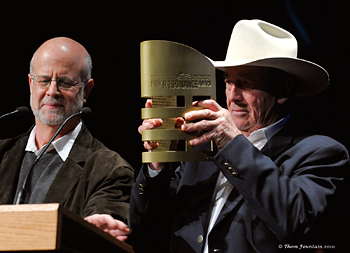Musically yours
December 25, 2010
On November 20th 2010, Sheldon Posen, Director of Ethnology and Cultural Studies, donned his best attire for the Canadian Folk Music Awards gala. He would be representing the Canadian Museum of Civilization to bestow its prestigious Resonance Award upon folk singer Ian Tyson. Surprised to hear that the Museum is involved in music? Try to imagine a civilization without music…
Our history in song
We all know about the Junos – but were you familiar with the Canadian Folk Music Awards? Created in 2005, their mission is to celebrate and promote Canadian folk music in all its forms. And when we think of the folk genre, we conjure up the music of daily life, of tradition…of history.
With its mandate to preserve and promote Canada’s social and cultural history, including its musical heritage, the Canadian Museum of Civilization was delighted to join in the dance. And so the Resonance Award was born in 2007, awarded every two years to an individual who makes an outstanding lifetime contribution to Canada’s musical heritage.
This time around, the Museum chose to bestow the Resonance Award to Canadian folk singing celebrity Ian Tyson. Penning songs such as Four Strong Winds and Some Day Soon which have been covered by dozens of artists and become international classics, Tyson has established himself as a true folk music legend. In the 80s, the singer-songwriter decided to heed his own lyrics and “go out to Alberta” where he now devotes his time to traditional Western music and raising horses – in true cowboy fashion.
Words and music
The Canadian Museum of Civilization’s foray into the world of music is not new. The preservation of Canada’s musical heritage is part of its mandate and the Museum actively pursues this goal.
Since the acquisition of its first wax cylinder recordings stemming from Alex T. Cringan’s research into the Iroquois people, the Museum’s audiovisual archives have constituted a unique record of the oral history of our First Nations, of our two founding peoples and of the numerous ethno-cultural groups that have established themselves in Canada.
From the wax cylinder to the MP3 file – with an obligatory passage through vinyl record and audiocassette – these archives illustrate the evolution of audio technology. How many teenagers know that we used to record songs onto wax?
The Museum’s archives are a treasure trove of discovery – an incredible resource for those who wish to learn a forgotten native language or unearth a lost traditional song. With some 77,000 audio recordings ranging from music and stories to thousands of hours of interviews, the collection is the repository of priceless living testimonials that each shed light, in their unique way, on a slice of our history. Our recorded words, music and heritage are retold in their original voice.